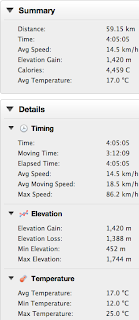Just down the road from Prato Piazza and Lago di Braies, the next climb rising from Val Pusteria along the Austrian border is Passo Furcia. It's a frequent Giro d'Italia climb and after riding it today I can see why. The north side starts easily near Valdaora (1020m), climbing through brilliant green pastures with views into Austria. Then after Gassl (1135m) you hit 2 km with average grade of 9.5%, including a half kilometer of 13%. It slacks off again before Sorafurcia (1340m), where you face 1.5 km of 12.3%. Again it cools down to 6.9% or so for the final stretch up to the pass at 1789m.
After passing a few ski lifts you head downhill. More great views from here of the grassy mountainsides and towns like San Viglio far below. You finally end up in the town of Longega at 1005m, in the upper end of Val Badia. Here you begin another panoramic climb through beautiful pasture country up through Rina (1375m), down a dip to 1330m then up again to the junction for Antermoia (1455m).
More fun starts here, with some 12% ramps on the climb out of Antermoia, followed by 5km of 9.5% to Passo delle Erbe (2004m) . Looming over the last few kilometers is Sasso Putia (2875m), with its very distinctive profile.
The ride down is fun. After Longega you gradually climb on the main road from Brunico to Corvara, quite busy this time of year. Then you turn upward through San Vigilio (1191m) and climb back up the grassy slopes. The difficulty varies between mild to hard until Raro Miso (1375m) when it becomes consistently hard- 3.5 km of 10.4% average gradient. This comes after you've completed challenging climbs up Passo Furcia from Valdaora, and Passo delle Erbe from Longega- quite tiring.
Highly recommended!
 |
Sasso Putia with Gruppo Sella in left background,
from descent of Passo Furcia |
 |
| Pieve di Marebbe from Passo Furcia descent |
 |
Corte di San Vigilio from climb toward Antermoia
(hazy!) |
 |
| Sasso Putia from climb toward Passo delle Erbe |
 |
| Sasso Putia from just below Passo |
 |
| Man mowing pasture above Antermoia |
 |
| View of Rina from above |
 |
| View down Val Badia from Costalungia |
 |
| Passo delle Erbe center, with Passo Furcia on either side |
 |
| The over 10% stretches |
 |
| The ride |
 |
| Passo Furcia from Valdaora to Longega |
 |
| Passo delle Erbe from Longega |
 |
| 214 kph sounds a tad high |























































